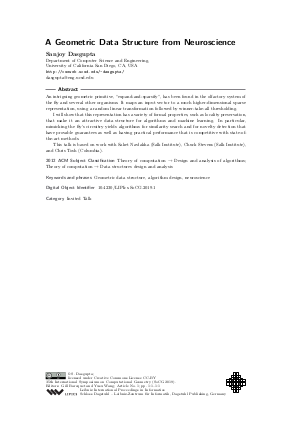A Geometric Data Structure from Neuroscience (Invited Talk)
Author Sanjoy Dasgupta
-
Part of:
Volume:
35th International Symposium on Computational Geometry (SoCG 2019)
Part of: Series: Leibniz International Proceedings in Informatics (LIPIcs)
Part of: Conference: Symposium on Computational Geometry (SoCG) - License:
 Creative Commons Attribution 3.0 Unported license
Creative Commons Attribution 3.0 Unported license
- Publication Date: 2019-06-11
File

PDF
LIPIcs.SoCG.2019.1.pdf
- Filesize: 178 kB
- 1 pages
Document Identifiers
Subject Classification
ACM Subject Classification
- Theory of computation → Design and analysis of algorithms
- Theory of computation → Data structures design and analysis
Keywords
- Geometric data structure
- algorithm design
- neuroscience
Metrics
- Access Statistics
-
Total Accesses (updated on a weekly basis)
0PDF Downloads0Metadata Views
Abstract
An intriguing geometric primitive, "expand-and-sparsify", has been found in the olfactory system of the fly and several other organisms. It maps an input vector to a much higher-dimensional sparse representation, using a random linear transformation followed by winner-take-all thresholding. I will show that this representation has a variety of formal properties, such as locality preservation, that make it an attractive data structure for algorithms and machine learning. In particular, mimicking the fly’s circuitry yields algorithms for similarity search and for novelty detection that have provable guarantees as well as having practical performance that is competitive with state-of-the-art methods. This talk is based on work with Saket Navlakha (Salk Institute), Chuck Stevens (Salk Institute), and Chris Tosh (Columbia).
Cite As Get BibTex
Sanjoy Dasgupta. A Geometric Data Structure from Neuroscience (Invited Talk). In 35th International Symposium on Computational Geometry (SoCG 2019). Leibniz International Proceedings in Informatics (LIPIcs), Volume 129, p. 1:1, Schloss Dagstuhl – Leibniz-Zentrum für Informatik (2019)
https://doi.org/10.4230/LIPIcs.SoCG.2019.1
BibTex
@InProceedings{dasgupta:LIPIcs.SoCG.2019.1,
author = {Dasgupta, Sanjoy},
title = {{A Geometric Data Structure from Neuroscience}},
booktitle = {35th International Symposium on Computational Geometry (SoCG 2019)},
pages = {1:1--1:1},
series = {Leibniz International Proceedings in Informatics (LIPIcs)},
ISBN = {978-3-95977-104-7},
ISSN = {1868-8969},
year = {2019},
volume = {129},
editor = {Barequet, Gill and Wang, Yusu},
publisher = {Schloss Dagstuhl -- Leibniz-Zentrum f{\"u}r Informatik},
address = {Dagstuhl, Germany},
URL = {https://drops.dagstuhl.de/entities/document/10.4230/LIPIcs.SoCG.2019.1},
URN = {urn:nbn:de:0030-drops-104055},
doi = {10.4230/LIPIcs.SoCG.2019.1},
annote = {Keywords: Geometric data structure, algorithm design, neuroscience}
}
